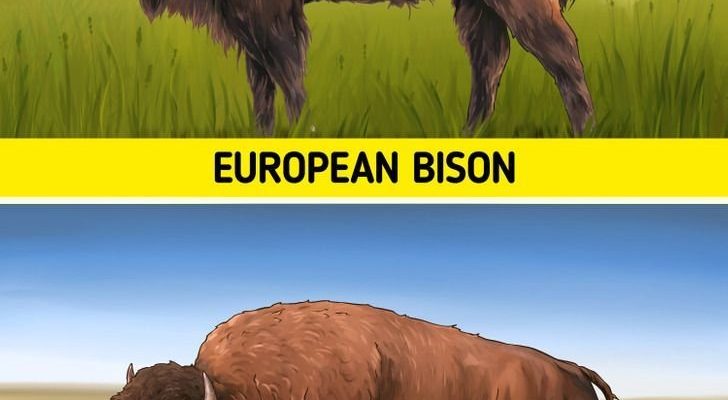![Comparing The European Bison Vs. [Similar Species]](https://gudri.com/wp-content/uploads/2025/06/Comparing_The_European_Bison_Vs___Similar_Species__image_0.jpg)
The European bison, known scientifically as *Bison bonasus*, roams the woodlands of Europe, particularly in Poland, Belarus, and parts of the Caucasus. On the other hand, the American bison, or *Bison bison*, is the iconic animal of the Great Plains in North America. These two bison species share some similarities, but their habitats, physical traits, and roles in their respective ecosystems showcase their distinct identities.
So, grab a cup of coffee, and let’s break down the fascinating differences and similarities between these two bison species.
The Habitat of European vs. American Bison
Both the European and American bison have adapted to their unique environments, but their habitats reflect contrasting lifestyles.
European Bison Habitat
The European bison thrives in *temperate forests*, predominantly in the Białowieża Forest, a UNESCO World Heritage site located on the border between Poland and Belarus. This species prefers *wooded areas* where they can find ample food such as leaves, shoots, and grasses. The dense forest provides cover from predators and harsh weather, allowing these majestic animals to flourish.
American Bison Habitat
Conversely, American bison are more suited to open *grasslands* and prairies. They roam the expansive lands of the Great Plains, where they can graze freely on tall grasses. This preference for open grasslands allows them to travel in herds, which offers protection against predators and enables them to find food more efficiently. These bison play a crucial role in maintaining the health of their ecosystem by controlling the growth of grass and providing nutrients to the soil through their waste.
Physical Characteristics of Each Bison
When you look at these two bison species side by side, their physical traits tell a compelling story.
European Bison Appearance
The European bison is slightly smaller and more lightweight than its American counterpart. They typically weigh between 1,000 to 2,200 pounds and stand about 5 to 6 feet tall at the shoulder. Their coats are made up of long, *thick hair*, giving them a shaggy appearance, especially during winter. The European bison also has a distinct hump on its back, formed by large muscles used for climbing hilly terrains.
American Bison Appearance
In contrast, the American bison is a true heavyweight, weighing anywhere from 1,000 to 2,500 pounds and standing 5 to 6.5 feet tall. Their build is more robust, with a massive head and prominent shoulder hump, making them look quite intimidating. The fur on an American bison is also thick, but it’s shorter than that of the European bison. During the winter months, the American bison might even have a frosty appearance due to frost collecting on their fur.
Diet and Feeding Habits
Both bison are herbivores, but their diets reflect the availability of vegetation in their respective habitats.
European Bison Diet
European bison tend to be browsers, meaning they eat a variety of *plant materials*. Their diet includes leaves, buds, fruits, and even bark from trees. In the winter, when food is scarce, they adapt by feeding on whatever is available, including the branches of trees. This adaptability is crucial for survival in their forested environment.
American Bison Diet
On the other hand, American bison are grazers. They primarily feast on *grasses* and other ground-level vegetation. These bison have strong, flat teeth designed for tearing up grass, which is abundant in their prairie habitat. You might find them in large herds, munching away, which helps control the grasslands and maintain a balanced ecosystem.
Social Structure and Behavior
Understanding the behavior and social dynamics of these bison provides insight into their lives in the wild.
European Bison Social Structure
European bison typically form matriarchal herds, where females lead and males may join during mating season. These herds usually consist of a few dozen animals, allowing them to remain close-knit for protection. Their social structure emphasizes cooperation, especially when it comes to caring for young calves.
American Bison Social Structure
In contrast, American bison often gather in larger herds, sometimes numbering in the thousands. These herds are less structured, with males and females coexisting until the breeding season. The dynamic within these herds can shift quickly, particularly when young males start challenging one another for dominance. Watching a herd of American bison can feel like observing a small city, full of activity and interaction.
Conservation Status and Challenges
Both species have faced significant challenges over the years, leading to varied conservation efforts.
European Bison Conservation Efforts
The European bison was once on the brink of extinction, with only a few dozen remaining in captivity in the early 20th century. Thanks to dedicated conservation efforts, including breeding programs and reintroductions into the wild, their numbers have rebounded to around 7,000 in the wild today. However, they still face threats from habitat loss and poaching.
American Bison Conservation Efforts
Similarly, the American bison experienced drastic declines in the 19th century due to overhunting and habitat destruction. Once numbering millions, they dropped to fewer than 1,000 individuals by the late 1800s. Conservation measures, such as the establishment of national parks and reserves, have helped increase their population to around 500,000 today. However, many American bison still live in managed herds that require ongoing efforts for their preservation.
In the grand tapestry of nature, both the European bison and American bison play vital roles as keystone species. While they share a lineage and some common traits, their habitats, diets, and social structures set them apart beautifully.
So, next time you think about bison, remember that they’re not just big, shaggy animals. They embody the rich diversity of life on our planet and remind us of the importance of conservation. By understanding and appreciating both species, we can better support their continued survival and the ecosystems they inhabit. Each bison tells a story, and by exploring their differences and similarities, we ensure that their tales continue to be told for generations to come.

